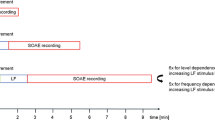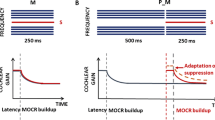Abstract
Threshold in quiet has always been of great interest in hearing research. Suprathreshold measurements, however, have usually been obtained for levels above 30 dB, leading to a lack of data for low levels. This lack became pronounced after the discovery of several effects all of which can be interpreted as stemming from nonlinear active feedback in the cochlea, which is especially effective at low levels. These effects are the following: level dependent basilar membrane displacement patterns (Rhode, 1971; Patuzzi et al., 1984), level dependent tuning curves in the inner hair cells (Russell and Sellick, 1978), three kinds of oto-acoustic emissions (Kemp, 1978; Ruggero et al., 1983; Schloth, 1983; Wilson, 1980a; Wit and Ritsma, 1980; Zurek, 1981) and the correlations between them (Zwicker and Schloth, 1984), and the large (2f.-f)-difference tones measured at low primary levels either as cancellation levels (Zwicker, 1981) or as oto-acoustic emission levels (Wilson, 1980b). An active preprocessing with nonlinear feedback, as discussed earlier in principle (Zwicker, 1979), has been realized in an analog model (Zwicker, 1986a) and in a digital model (Zwicker and Lumer, 1985); both models clearly demonstrate the effects described above (Zwicker, 1986b).
Access this chapter
Tax calculation will be finalised at checkout
Purchases are for personal use only
Preview
Unable to display preview. Download preview PDF.
Similar content being viewed by others
References
Dallmayr, C. (1985). Spontane oto-akustische Emissionen, Statistik und Reaktion auf akustische Störtöne, Acustica, 59, 67–75.
Dallmayr, C. (1985). Spontane oto-akustische Emissionen, Statistik und Reaktion auf akustische Störtöne, Acustica, 59, 67–75.
Kemp, Ü.T. (1978). Stimulated acoustic emissions from within the human auditory system, J. Acoust. Soc. Am., 64, 1386–1391.
Kemp, D.T. (1979). The evoked cochlear mechanical response and the auditory microstructure - evidence for a new element in cochlear mechanisms, Scand. Audiol. Suppl., 9, 35–47.
Long, G.R. (1984). The microstructure of quiet and masked thresholds, Hearing Res., 15, 73–87.
Patuzzi, R., Sellick, P.M., and Johnstone, B.M. (1984). The modulation of the sensitivity of the mammalian cochlea by low frequency tones. III. Basilar membrane motion, Hearing Res., 13, 19–27.
Rhode, W.S. (1971). Observations of the Vibration of the Basilar Membrane in Squirrel Monkeys using the Mössbauer Technique, J. Acoust. Soc. Am., 49, 1218–1229.
Ruggero, M.A., Rich, N.C., and Freyman, R. (1983). Spontaneous and impulsively evoked oto-acoustic emissions: Indicators of cochlear pathology?, Hearing Res., 10, 283–300.
Russell, I.J., and Sellick, P.M. (1978). Intracellular studies of hair cells in the mammalian cochlea, J. Physiol., 284, 261–290.
Scherer, A. (1984). Evozierte oto-akustische Emissionen bei Vor- und Nachverdeckung, Acustica, 56, 34–40.
Schloth, E. (1983). Relation between spectral composition of spontaneous oto-acoustic emissions and fine-structure of threshold in quiet, Acustica, 53, 250–256.
Wilson, J.P. (1980a). Evidence for a cochlear origin for acoustic re- emission, threshold fine-structure, and tonal tinnitus, Hearing Res., 2, 233–252.
Wilson, J.P. (1980b). The combination tone 2f1 - f2 in psychophysics and earcanal recording, in: Psychophysical, Physiological and Behavioural Studies in Hearing, G. van den Brink and F.A. Bilsen, eds., Delft U.P., Delft, pp. 43–50.
Wit, H.P., and Ritsma, R.J. (1980). Evoked acoustical emissions from the human ear: Some experimental results, Hearing Res., 2, 253–261.
Zurek, P.M. (1981). Spontaneous narrow-band acoustic signals emitted by human ears, J. Acoust. Soc. Am., 69, 514–523.
Zwicker, E. (1952), Die Grenzen der Hörbarkeit der Amplitudenmodulation und der Frequenzmodulation eines Tones, Acustica, Akustische Beihefte AB 125–AB 133.
Zwicker, E. (1979). A model describing nonlinearities in hearing by active processes with saturation at 40 dB, Biol, Cybernetics, 35, 243–250»
Zwicker, E. (1979), Dependence of level and phase of the (2f1-f2) cancellation tone on frequency range, frequency difference, level of primaries and subject, J. Acoust. Soc. Am., 70, 1277–1288.
Zwicker, E. (1979), Dependence of level and phase of the (2f1-f2) cancellation tone on frequency range, frequency difference, level of primaries and subject, J. Acoust. Soc. Am., 70, 1277–1288.
Zwicker, E. (1979), Dependence of level and phase of the (2f1-f2) cancellation tone on frequency range, frequency difference, level of primaries and subject, J. Acoust. Soc. Am., 70, 1277–1288.
Zwicker, E., and Feldtkeller, R. (1967). Das Ohr als Nachrieht enemp f än- ger, 2. edition, Hirzel-Verlag, Stuttgart.
Zwicker, E., and Lumer, G. (1985). Evaluating traveling wave characteristics in man by an active nonlinear cochlear preprocessing model, in: Peripheral Auditory Mechanisms, J.B. Alan et al., eds., Springer, Berlin, pp. 250–257.
Zwicker, E., and Schloth, E. (1984). Interrelation of different oto- acoustic emissions, J. Acoust. Soc. Am., 75, 1148–1154.
Horst, J.W., Wit, H.P. and Ritsma, R.J. (1983). Psychophysical aspects of cochlear emissions (“Kemp-tones”), in: Hearing - Physiological Bases and Psychophysics, pp.89–96, R. Klinke and R. Hartmann, eds., Springer- Verlag, Berlin.
Jones, K., Tubis, A., Long, G.R., Burns, E.M. and Strickland, E.A. (1986). Interactions among multiple spontaneous emissions, ins Peripheral Auditory Mechanisms, J.B. Allen, J.L. Hall, A. Hubbard, S.T. Neely and A. Tubis, eds., Springer-Verlag, 266–273.
Author information
Authors and Affiliations
Editor information
Editors and Affiliations
Rights and permissions
Copyright information
© 1986 Plenum Press, New York
About this chapter
Cite this chapter
Zwicker, E. (1986). Spontaneous Oto-Acoustic Emissions, Threshold in Quiet, and Just Noticeable Amplitude Modulation at Low Levels. In: Moore, B.C.J., Patterson, R.D. (eds) Auditory Frequency Selectivity. Nato ASI Series, vol 119. Springer, Boston, MA. https://doi.org/10.1007/978-1-4613-2247-4_6
Download citation
DOI: https://doi.org/10.1007/978-1-4613-2247-4_6
Publisher Name: Springer, Boston, MA
Print ISBN: 978-1-4612-9316-3
Online ISBN: 978-1-4613-2247-4
eBook Packages: Springer Book Archive




